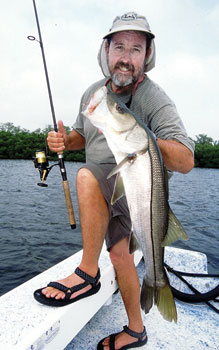Historic freeze could have a silver lining
From the January 27, 2010 Issue
PHOTO PROVIDED
Captain Scott Moore
holds a healthy snook a client landed
in Charlotte Harbor. Habitat is critical
to the viability of the fishery as well
as
tourism, both of which support guides,
boat builders and all business that
line Florida's coasts.
Hopefully, the historic cold weather that has decimated fish stocks state-wide is behind us for this year. It’s only the end of January, but already we’ve experienced the most devastating cold wave in more than a century. The record breaking temperatures caused massive fish kills as far away as Flamingo and Islamorada. Chief among the victims are snook, tarpon, bonefish, cravelle jacks; but species including catfish, grouper, snapper and even mullet perished in large numbers. It seems the worst damage occurred along the lower west coast of Florida in the Everglades near Flamingo. While it may seem counter-intuitive that snook that far south would fare worse than in our area, our fish fared reasonably well (although large numbers perished) because they are acclimated to colder temperatures in the winter months. The fringes of Tampa Bay have long been associated with the northern range of snook. A decade or longer warming trend has extended their range (according to anecdotal evidence) as far N orth as South Carolina and Texas. By any measure the loss of valuable recreation species has been historic as reports of the true extent are yet to be recorded and may never be known.
According to Rick Robert, executive director of the Snook Foundation, scientists conducting a fish count in the Peace River found only four live snook in a day of sampling. According to Roberts, the potential benefit to this historic kill may lie in the opportunity to make anglers and the public aware of the need to protect the habitat required to help stressed species recover. The statistics are sobering. Since the last great freeze in the early forties, Florida has lost close to 50 percent of the habitat that supported fish populations. In the 30 years I’ve been living in central Florida the focus of fisheries management has revolved around protecting species from over-fishing. That strategy, while admittedly necessary, seems unlikely to protect the resource in the future. Texas is a case in point. After more than a decade of releasing hatchery raised redfish into their bays and estuaries studies indicate that fewer than 3 percent survived to maturity. Robert’s point seems well taken: “Unless the Sleeping Giant that is the recreational fishing community acts to demand protection for shrinking habitat in Florida, they can expect to experience a significant drop in the fishery.”
Once again we only have to scratch the surface to see the devastating potential of habitat loss. In Florida alone, over 280 species of fish share the available habitat with manatees, crustaceans and a plethora of shore birds and other creatures.
To get an idea of the importance the state gives to fisheries and habitat, consider the fact that agriculture, which creates fewer jobs and revenue for the state than our coastal fisheries resource receives significant subsidies from the government.
“Most of the crops that were lost in the freeze have already been replanted” says Roberts. “Fisheries, on the other hand, continue to lose ground even in the face of the sobering statistics evidenced by red tides and killer freezes.”
Now is the time for organizations like The Snook Foundation, Sarasota Bay Watch, the Coastal Conservation Association and other stakeholders to ban together to reverse the alarming trend of habitat loss.
According to Roberts, “The Snook Foundation, with the help of respected scientists including Dr. Aaron Adams, plans to form the “Angler’s Action Plan,” an initiative aimed at supplying lawmakers and decision makers the empirical evidence they need to make enlightened decisions."
With the help of divergent organizations and individuals that depend on healthy fisheries resources it will be possible for politicians and policy makers to get the message that they will be held responsible by their constituents for decisions that impact critical habitat. This must be a bottom up approach initiated by individuals that enjoy and make their living from Florida’s estuaries. For more information contact Rick Roberts at the Snook Foundation, rick@snookfoundation.org.

